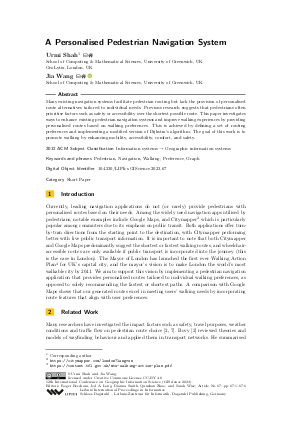A Personalised Pedestrian Navigation System (Short Paper)
Authors
Urmi Shah,
Jia Wang 
-
Part of:
Volume:
12th International Conference on Geographic Information Science (GIScience 2023)
Part of: Series: Leibniz International Proceedings in Informatics (LIPIcs)
Part of: Conference: International Conference on Geographic Information Science (GIScience) - License:
 Creative Commons Attribution 4.0 International license
Creative Commons Attribution 4.0 International license
- Publication Date: 2023-09-07
File

PDF
LIPIcs.GIScience.2023.67.pdf
- Filesize: 2.85 MB
- 6 pages
Document Identifiers
Subject Classification
ACM Subject Classification
- Information systems → Geographic information systems
Keywords
- Pedestrian
- Navigation
- Walking
- Preference
- Graph
Metrics
- Access Statistics
-
Total Accesses (updated on a weekly basis)
0Document
0Metadata
Abstract
Many existing navigation systems facilitate pedestrian routing but lack the provision of personalised route alternatives tailored to individual needs. Previous research suggests that pedestrians often prioritise factors such as safety or accessibility over the shortest possible route. This paper investigates ways to enhance existing pedestrian navigation systems and improve walking experiences by providing personalised routes based on walking preferences. This is achieved by defining a set of routing preferences and implementing a modified version of Dijkstra’s algorithm. The goal of this work is to promote walking by enhancing mobility, accessibility, comfort, and safety.
Cite As Get BibTex
Urmi Shah and Jia Wang. A Personalised Pedestrian Navigation System (Short Paper). In 12th International Conference on Geographic Information Science (GIScience 2023). Leibniz International Proceedings in Informatics (LIPIcs), Volume 277, pp. 67:1-67:6, Schloss Dagstuhl – Leibniz-Zentrum für Informatik (2023)
https://doi.org/10.4230/LIPIcs.GIScience.2023.67
BibTex
@InProceedings{shah_et_al:LIPIcs.GIScience.2023.67,
author = {Shah, Urmi and Wang, Jia},
title = {{A Personalised Pedestrian Navigation System}},
booktitle = {12th International Conference on Geographic Information Science (GIScience 2023)},
pages = {67:1--67:6},
series = {Leibniz International Proceedings in Informatics (LIPIcs)},
ISBN = {978-3-95977-288-4},
ISSN = {1868-8969},
year = {2023},
volume = {277},
editor = {Beecham, Roger and Long, Jed A. and Smith, Dianna and Zhao, Qunshan and Wise, Sarah},
publisher = {Schloss Dagstuhl -- Leibniz-Zentrum f{\"u}r Informatik},
address = {Dagstuhl, Germany},
URL = {https://drops.dagstuhl.de/entities/document/10.4230/LIPIcs.GIScience.2023.67},
URN = {urn:nbn:de:0030-drops-189628},
doi = {10.4230/LIPIcs.GIScience.2023.67},
annote = {Keywords: Pedestrian, Navigation, Walking, Preference, Graph}
}
Author Details
- School of Computing & Mathematical Sciences, University of Greenwich, UK
- GeoLytix, London, UK
References
- Asha Weinstein Agrawal, Marc Schlossberg, and Katja Irvin. How far, by which route and why? a spatial analysis of pedestrian preference. Journal of Urban Design, 13(1):81-98, 2008. URL: https://doi.org/10.1080/13574800701804074.
-
Piet H Bovy and Eliahu Stern. Route choice: Wayfinding in transport networks: Wayfinding in transport networks, volume 9. Springer Science & Business Media, 2012.

- Achituv Cohen and Sagi Dalyot. Route planning for blind pedestrians using openstreetmap. Environment and Planning B: Urban Analytics and City Science, 48(6):1511-1526, 2021. URL: https://doi.org/10.1177/2399808320933907.
- Ioannis Delikostidis, Corné P.J.M. van Elzakker, and Menno-Jan Kraak. Overcoming challenges in developing more usable pedestrian navigation systems. Cartography and Geographic Information Science, 43(3):189-207, 2016. URL: https://doi.org/10.1080/15230406.2015.1031180.
- Zhixiang Fang, Qingquan Li, and Shih-Lung Shaw. What about people in pedestrian navigation? Geo spatial Inf. Sci., 18(4):135-150, 2015. URL: https://doi.org/10.1080/10095020.2015.1126071.
- Joan Henderson. Making cities more walkable for tourists: A view from singapore’s streets. International Journal of Tourism Cities, 4(3):285-297, 2018. URL: https://doi.org/10.1108/IJTC-11-2017-0059.
- Serge P Hoogendoorn and Piet HL Bovy. Pedestrian route-choice and activity scheduling theory and models. Transportation Research Part B: Methodological, 38(2):169-190, 2004. URL: https://doi.org/10.1007/978-94-009-0633-4.
- David Jonietz. Personalizing walkability: A concept for pedestrian needs profiling based on movement trajectories. In Tapani Sarjakoski, Maribel Yasmina Santos, and L. Tiina Sarjakoski, editors, Geospatial Data in a Changing World - Selected Papers of the 19th AGILE Conference on Geographic Information Science, Helsinki, Finland, 14-17 June 2016, Lecture Notes in Geoinformation and Cartography, pages 279-295. Springer, 2016. URL: https://doi.org/10.1007/978-3-319-33783-8_16.
- Ian T. Ruginski, Nicholas A. Giudice, Sarah H. Creem-Regehr, and Toru Ishikawa. Designing mobile spatial navigation systems from the user’s perspective: an interdisciplinary review. Spatial Cogn. Comput., 22(1-2):1-29, 2022. URL: https://doi.org/10.1080/13875868.2022.2053382.
- Panote Siriaraya, Yuanyuan Wang, Yihong Zhang, Shoko Wakamiya, Péter Jeszenszky, Yukiko Kawai, and Adam Jatowt. Beyond the shortest route: A survey on quality-aware route navigation for pedestrians. IEEE Access, 8:135569-135590, 2020. URL: https://doi.org/10.1109/ACCESS.2020.3011924.
- Jia Wang, Zena Wood, and Michael F. Worboys. Conflict in pedestrian networks. In Tapani Sarjakoski, Maribel Yasmina Santos, and L. Tiina Sarjakoski, editors, Geospatial Data in a Changing World - Selected Papers of the 19th AGILE Conference on Geographic Information Science, Helsinki, Finland, 14-17 June 2016, Lecture Notes in Geoinformation and Cartography, pages 261-278. Springer, 2016. URL: https://doi.org/10.1007/978-3-319-33783-8_15.
